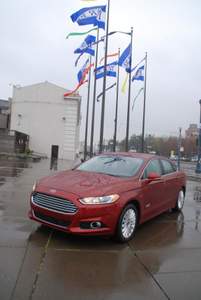 The enthusiast group Plug In America noted that U.S. sales of plug-in electric cars (either pure electrics or plug-in hybrids) will pass a significant milestone a month ago (May 2013). The 100,000 sales mark was reached just two and a half years after their introduction to the market in December 2010. Plug In America is commemorating the “historic” moment with an award contest and by launching a counter on its website that tracks EV sales. The counter is updated using sales data from the most recent published reports.
The enthusiast group Plug In America noted that U.S. sales of plug-in electric cars (either pure electrics or plug-in hybrids) will pass a significant milestone a month ago (May 2013). The 100,000 sales mark was reached just two and a half years after their introduction to the market in December 2010. Plug In America is commemorating the “historic” moment with an award contest and by launching a counter on its website that tracks EV sales. The counter is updated using sales data from the most recent published reports.
“Our current estimate, based on monthly sales figures from automakers, is that the 100,000th highway-capable plug-in vehicle will be sold on May 20,” said Tom Saxton, Plug In America’s chief science officer. “We are calling this the #PIA100K mark, and we are excited to see the continued growth of the market.”
The group also cited other side notes of the sales milestone:
- More than a quarter-million people are exposed daily to the benefits of electric transportation.
- Nissan dealerships in some select markets have reported that the Leaf has outsold all other Nissan models for particular sales periods this year.
- Tesla’s Model S is outselling the Mercedes-Benz S-Class (as noted in the Clean Fleet Report story from May 19) and other luxury competitors–the BMW 7 series and the Audi A8–for the first four months of the year.
- Chevy Volt drivers alone have logged over 187 million electric miles.
- The plug-in vehicle market is approaching 48 percent annual growth with both Battery Electric (BEV) and Plug-in Hybrid (PHEV) vehicles finding growing interest.
- The plug-in vehicle adoption rate exceeds the adoption rate of hybrid vehicles over the same time frame in their early market introduction.
- The domestic EV fleet now offers over 2,000 megawatts of battery storage, which may offer significant opportunities for the future management of our electrical grid and the increasing role of intermittent renewable energy sources
- Manufacturers making EVs now include Nissan, Tesla, GM, Ford, Honda, Mitsubishi, Toyota, BMW, Mercedes, and Fiat (see CFR article, The Top 10 Electric Vehicles You can Buy-Finally). These plug-in cars have received a wealth of consumer and industry awards.
Plug In America board member Barry Woods offered his take on the 100,000th sale in a recent Plug In America blog post. Here are some of his thoughts:
“Even as recently as six months ago, when I would go into auto dealerships to sell (electric vehicle) chargers, they would listen politely and tell me they had sold very few Volts or Leafs and their customers weren’t interested in charging stations.
“Now when I go into auto dealers, they invite me back to speak to their sales staff and discuss charging as an issue and what their customers will need to make better use of the car’s range capabilities. Anecdotally, in March in Portland’s metro area, Nissan dealers collectively sold more 2013 Leafs than any other model- including the Altima- over 65 units between the four major dealerships. Tesla’s stock is up over 50% since the beginning of the year. 24,551 PEVs have been sold this year through April, practically matching the entire PEV [plug-in vehicle] sales for all of 2011.
“Over 95,000 PEVs have now been sold. We were correct about the prospects for growth of PEV technology, as their sales progress outpacing the growth of the hybrid vehicle over its first three years. We were correct in believing that the American consumer would accept an alternative choice besides gasoline if the technology delivered performance and savings over the long haul. A virtuous market- and policy-based cycle has developed to bring down prices and spur R&D. We appreciate that these vehicles are not just “green,” they are advanced vehicle technology creating better transportation choices and superior driving experiences.”
The sales are exciting, particularly for the enthusiastic early adopters of this technology. But, to keep the achievement in perspective, after more than a decade on the market hybrid vehicles account for only about 3% of the overall automotive market. Some analysts questioned whether plug-in models would take away sales from the non plug-in hybrid segment, but that doesn’t appear to be the case. While Toyota’s vast array of hybrid vehicles have seen decreased sales, the slack has been picked up by other entrants in the category, including Ford, Kia and General Motors as well as new models from VW and BMW. Additionally, it should be noted that the vast majority of plug-in sales are in California, the state that has mandated automakers to produce zero or near-zero-emission vehicles. Some of the plug-ins are not even available in other states while others are available only as lease vehicles, but not for sale.
Still, the 100,000 sales mark is significant, but it’s only the first step in a long road toward a mass market for plug-in electric cars. Keep in mind that the best-selling vehicle in America, the Ford F-Series pickup, sells that many models in less than two months, not two years. And keep in mind that traditional engines are getting more and more sophisticated and efficient, posing another challenge until purchase prices on electric cars come down. So celebrate, then buckle down for the task is just beginning.
This article originally appeared in Clean Fleet Report (www.cleanfleetreport.com). Used by persmission.



